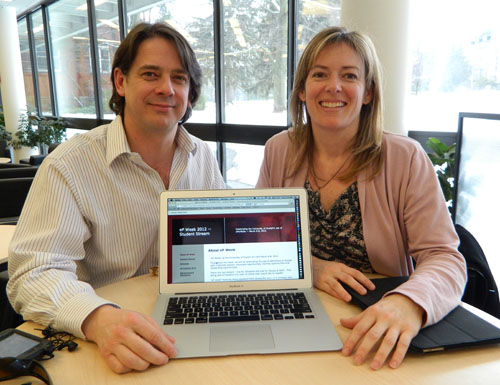
When instructional technology specialist Jason Thompson’s manager asked him “what do you do all day?” Thompson had a creative way to answer that question. He created an ePortfolio with a page that displayed his workday schedule and linked to other pages with photos of himself at work, a video of a participant making a comment during one of his workshops and some reflections on how his day was spent.
“It was an effective way to demonstrate what I do,” says Thompson.
What’s an ePortfolio and what can it do for you? Come to the Centre for Open Learning and Educational Support’s ePortfolio Week to find out. To register for workshops scheduled March 6 to 8, visit http://coles.uoguelph.ca/epweek. If you’re a student at U of G, you can enter the 2012 eP contest for a chance to win an iPad.
The ePortfolio tool itself is accessible to all students, staff and faculty through CourseLink. You can use it to collect evidence of your learning and help you reflect on your learning journey. It can help you make connections between school and extra-curricular activities and professionalize your web presence, says Thompson. It may even help you get a job.
School of Hospitality and Tourism Management (HTM) lab instructor Alison Crerar completed a research study in 2010 on ePortfolio use after being introduced to the tool during a U of G workshop. “I was interested in how business students would use ePortfolios to promote themselves to potential employers,” she says. “This profession (hotel tourism management) doesn’t predominantly use portfolios, electronic or otherwise, in the recruitment process.”
To test it out, she assigned co-op students who had finished their 12-month work term to create an ePortfolio presentation that they would use to market themselves for employment. They were required to include a link to allow for a printable resume but were given “carte blanche” for presentation style and content.
She asked students to comment on the process and whether they thought it would be a useful tool for obtaining employment. Most did. “At first, many of them found it hard to organize their information because they didn’t have any of their files previously stored in the ePortfolio tool,” Crerar says. “But after they’d done it, most students said it helped them see how they had developed skills through assignments and work experience.” Many students said they felt much better prepared for job interviews after going through the process of creating the ePortfolio.

“Employers may know that you have a degree, but they don’t know what’s underneath that piece of paper,” adds Crerar. “Through your ePortfolio you can show them what courses you took and what projects you completed and how curricular and extra-curricular activities link to skills employers are looking for. It’s evidence of your learning.”
Crerar also took a sample ePortfolio to employers who came to the HTM career fair and asked them to complete a survey about it. The employers agreed that an ePortfolio could effectively showcase a student’s competence and skills and felt that it was appropriate for use when applying for mid-level or management positions.
“When I talk to students about ePortfolios, I start by talking about who they are in the digital world,” says Crerar. “Employers are using the web to find out what’s out there about you. Your ePortfolio gives you a positive web presence, something you control.” She recommends that graduating students put the link to their ePortfolio in their cover letter when using a traditional paper-based resume. You can also use the interview process to get your ePortfolio out to employers.
Thompson describes three types of ePortfolios: the showcase or career ePortfolio designed to show potential employers what you’ve learned or accomplished; the learning ePortfolio that helps you organize and demonstrate what you’ve learned; and the professional or accreditation ePortfolio used to gather the necessary material for accreditation or to demonstrate professional competency.
Of course, ePortfolios can also be used in other ways, such as Thompson’s dynamic answer to his manager’s question. “The ePortfolio in CourseLink is a user tool and is not tied to a particular course. Users have control over what they add, the presentations they create and who can view specific presentations within their ePortfolios,” he says.
The ePortfolio’s foundation is a virtual filing cabinet where people can store “artifacts.” An artifact could be a photo, a video, a sound file, a scanned document, an essay or any other electronic file. When a presentation is needed, various items can be pulled from the filing cabinet and incorporated into the ePortfolio presentation. No need to worry about finding that certificate you earned or the photo of you volunteering – it’s all there through the University’s CourseLink server.
This makes the tool useful in teaching as well. The ePortfolio Week keynote presentation focuses on documenting learning with ePortfolios. Another workshop highlight is a video conference planned with Prof. Chris Finnin from LeBow Business College, who is involved in integrating ePortfolio assignments throughout a five-year business program. A showcase from U of G’s College of Arts and sessions for faculty and graduate students on using ePortfolios for professional development are also scheduled. For more information about ePortfolio Week 2012 or ePortfolio initiatives at the University of Guelph, go to http://coles.uoguelph.ca/epweek or contact Kyle Mackie at kmackie@uoguelph.ca or Jason Thompson at jathomps@uoguelph.ca.